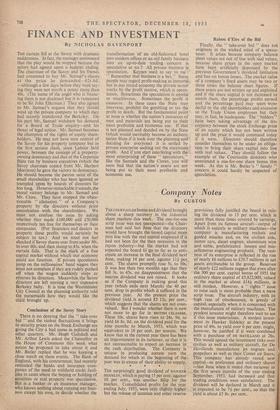Company Notes
By CUSTOS THE COURTAULDS bonus and dividend brought about a sharp recovery in the industrial share markets this week. The one-for-one scrip issue was not unexpected—the Chair- man had said last June that the directors would have brought the issued capital more into line with the real capital employed if it had not been for the then recession in the rayon industry—but the market had not expected the board kigo so far as to anti- cipate an increase in the final dividend next June, making 14 per cent. against 111 per cent. The shares promptly rose 5s. to 50s. It was less than two months ago that they fell 3s. to 45s. on disappointment that the interim dividend was not raised. It looks as if the Company is making good this year (which ends next March) the 40 per cent. drop in profits which it suffered in the previous year. At the present price the dividend yield is around £5 12s. per cent., which suggests that the shares are not over- valued. But I wonder whether there is now not more to go for in BRITISH CELANESE. These 10s. shares have risen to 24s. 9d. to yield £6 8s. Od. on the dividend paid for the nine months to March, 1953, which was' equivalent to 16 per cent. per annum. We know that in the current year there has been an improvement in its turnover, so that it is not unreasonable to expect an increase in the cash distribution. The Company is unique in producing acetate yarn the demand for which at the beginning of the year was in excess of their ability to supply.
THE surprisingly good dividend of HAWKER SIDDELEY, which is paying 15 per cent. against 10 per cent., was another fillip for the market. Consolidated profits for the year ending July, 1953, were only slightly higher but the release of taxation and other reserve provisions fully justified the board in rais- ing the dividend to 15 per cent. which is more than three times covered by earnings. Apart from its famous aircraft—output of which is entirely in military machines—the company is manufacturing rockets and guided missiles and, on the civilian side, motor cars, diesel engines, aluminium wire and cable, prefabricated houses and mis- cellaneous engineering productg. The vast- ness of its enterprise is reflected in the rise of nearly £6 millions to £29.7 millions in net assets attributable to the group. Reserves of nearly £22 millions suggest that even after the 300 per cent. capital bonus of 1951 the ordinary share capital of £5,822,000, valued in the market at about £141 millions, is still modest. However, a " rights " issue to raise cash is more probable than a mere scrip issue. The aircraft industry, with its high rate of obsolescence, is greedy of capital, especially when it is concerned with the manufacture of military machines. The prudent investor might therefore wait to see if this issue materialises. A modest invest- ment in Hawker Siddeley at the present price of 49s. to yield over 6 per cent, might, however, be justified if it were combined with a purchase of DE HAVILLAND at 28s. This would spread the investment risks over civilian as well as military aircraft, for De Havillands manufacture jet engines and propellors as well as their Comet air liners. This company has already raised new capital—in preference and ordinary shares —last June when it stated that turnover in the first seven months of the year ending September, 1953, had increased and that trading conditions were satisfactory. The dividend will be declared in March and it is expected to be 71 per cent., so that the yield is about £5 8s. per cent.










































 Previous page
Previous page